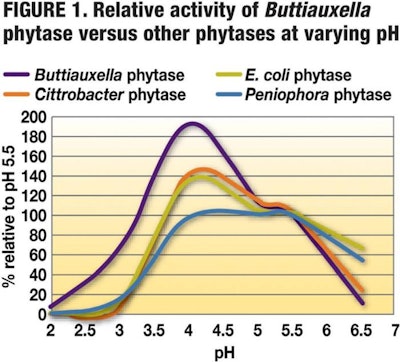
The environmental impact and feed cost reductions benefits of phytase are well recognized in the animal feed industry. Consequently, competition in the phytase market has increased dramatically over the past few years. With an increasing number of phytases on the market, there may be some confusion about which one would be best for your particular feed formulation. You could select one randomly "out of a hat" or be tempted by the cheapest option; however, when you consider the particular conditions of the animal's digestive tract and the specific needs of your feed business, it's clear that not all phytases will deliver the same value.
Determining your overall phytase needs
The current global phytase market is estimated to be worth approximately $350 million annually. The average penetration rate of phytase across all diets for swine is approximately 70 percent; the poultry industry is showing closer to 90 percent adoption. The growth of the phytase market so far has mainly been driven by two factors: a need to replace inorganic phosphates in animal diets due to their increasing costs; and concerns about the impact of animal production on the environment -- specifically, the minimization of phosphorus wastage.
A better understanding of the phytate molecule in recent years has lead to the realization that novel phytases have benefits beyond phosphorus release. Phytases have been shown to reduce the anti-nutrient effects of phytate in animal diets by degrading it, thereby, increasing the availability of energy and amino acids. This provides the potential for phytases to further reduce the cost of feed, particularly when the price of energy and protein/amino acids in diets is high.
Recent research in piglets has shown that the phytate level in nursery diets has a significant impact on growth performance, and commercial trials have proven that increased levels of certain phytases in diets can improve performance in nursery pigs. Phytase use also affords the opportunity to switch to alternative energy and protein sources with higher phytate levels without compromising the overall nutritional value of the diet.
Phytate reduces the availability of nutrients to the animal because it forms complexes with protein, calcium and trace elements in the digestive tract, which decreases the nutritional value of diet formulations. At acidic pH levels (pH<4.5) in the upper part of the digestive tract, e.g. pig's stomach and poultry gizzard, phytate will bind to proteins and form complexes. The phytate-protein complex is not a suitable substrate for endogenous proteases, including pepsin; such complexes can also impede protein digestion with negative implications for amino acid digestibility. Since pepsin is unable to attack the phytate-protein complex, gastric secretions of pepsin and hydrochloric acid are increased as a compensatory mechanism. Extra gastric secretion production consumes nutrients and energy, resulting in reduced animal performance.
Five ideal phytase characteristics
The type of phytase to choose depends on the degree of cost saving you want to make from improving nutrient uptake -- in other words, how aggressive you want to be about applying full nutrient matrix values with confidence. It also depends on your view of phytate as an anti-nutrient.
Research has shown significant differences between phytases in bio-efficacy, both in terms of improving digestibility and reducing the anti-nutrient effects of phytate in animal diets. Here are some of the things you might want to consider to achieve stronger levels of performance and profitability from phytase:
1. High activity at low pH
Phytases have their own individual pH optima at which they function at their best. In order to improve phosphorous (P) uptake and reduce the anti-nutrient effects of phytate, a phytase needs to be highly active at the low pH conditions prevailing in the upper digestive tract. Figure 1 highlights the difference between E.coli phytases and a new Buttiauxella phytase in terms of activity at low pH where the Buttiauxella phytase shows a clear advantage.
2. High affinity for IP6 phytate
Phytate consists of an inositol ring with six phosphate groups (IP6). Numerous studies have shown that the anti-nutritive effect from phytate is considerably reduced as soon as phytase removes one phosphate group from the intact inositol ring. The lower molecular weight esters, such as IP5 and IP4 do not possess the same binding power for protein and trace minerals as the IP6 molecule. Consequently, a phytase that rapidly cleaves a phosphate group from an IP6 molecule and then preferentially moves onto another IP6 molecule will be very powerful in terms of reducing the anti-nutrient effects of phytate as well as making more P available to the animal.
3. Speed of release
The speed at which the phytase cleaves a phosphate group from the inositol ring (IP6) in the upper digestive tract will also determine the bio-efficacy of the phytase in the animal. The faster the phytase gets to work, the more the anti-nutrient effect of the phytate molecule in the stomach and upper gut can be reduced; and more nutrients are released for the animal to absorb from the digestive tract. This means the dose of phytase required to counter the anti-nutrient effect of phytate is potentially reduced, P uptake is increased and the phytase becomes more cost-effective in its application.
4. High thermostability, up to 95°C (203°F)
Significant loss of phytase activity during steam conditioning and pelleting of feed is a limiting factor in phytase use. There are two ways of making enzymes more heat-stable. One approach is to use a coating to protect the enzyme; the other is to manipulate enzymes into more thermostable variants. Both technologies have been found to significantly improve enzyme stability and have been successfully used to produce commercial products. A good coating needs to protect the enzyme molecule through the feed manufacturing process, but also needs to release the product very quickly in the upper part of the gut to ensure optimum bio-efficacy is achieved.
5. In vivo scientific proof
Animal trials to validate the bio-efficacy of a phytase and gauge responses to different phytase levels are costly. However, they are a necessity to establish reliable matrix values. The amount of data behind a phytase will determine how confident you can be in applying the matrix values in a feed formulation. Pigs and poultry respond differently to phytase and the age of an animal can also influence how responsive they are. These are further factors that need quantifying during in vivo trials.
Can you have it all?
The short answer is yes. Phytases are continuously evolving in terms of the value they can bring to feed formulations. Thanks to major phytase producers being strongly committed to science and delivering the best value solutions to their customers, many research dollars have been invested in improving phytase efficacy and satisfying the customer needs of tomorrow.
References on request.

















